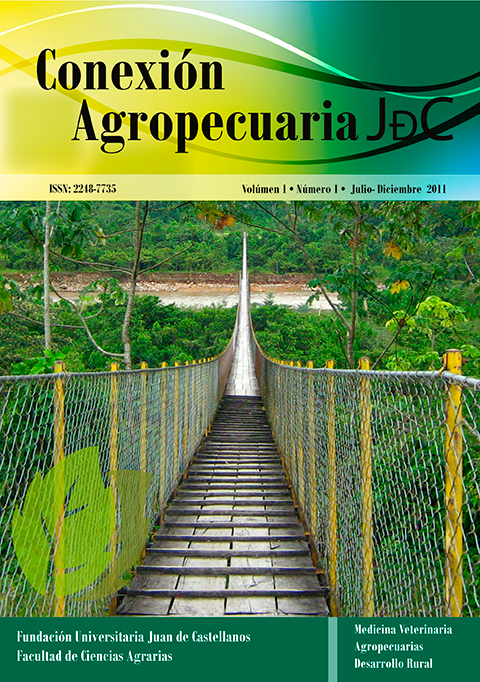Keywords:
Scarabaeidae, Montane Rain Forest, Canthonini, Ateuchini, OnthophaginiAbstract
In the Private Reserve, Refugio del Oso de Anteojos (El Calvario-Meta), the diversity of dung beetles was studied (Coleoptera: Scarabaeinae), grouped around different types of vegetation (Montane Rain Forest, Rainforest Premontane, Lower Montane Rain Forest), by using pitfall traps baited with human dung. During the samplings carried out in the rainy station on 2008, were captured a total of 177 individuals belonging to 9 species. The tribe Canthonini was the most representative with 87.5%, of the described species, followed by Aechini 10.8%, and Onthophagini 1.7%. The dominant species was Canthon lituratus in the three vegetation units: Lower montane rain forest was the richest (9 species) and abundance (86 individuals), compared with other environments sampled. By calculating the complementarity index, shows a similar species composition in the three habitats sampled, possibly, related to the floristic composition presented in each one of them.
Downloads
References
Camacho, R. A. (1999). Usos de las cercas vivas por parte de los escarabajos coprófagos (Escarabaeidae: Scarabaeinae) en un ambiente fragmentado del piedemonte llanero. Meta, Colombia. Santafé de Bogotá: Pontificia Universidad Javeriana, Facultad de Ciencias.
Celi, J. & Dávalos, A. (2001). Manual de monitoreo: Los escarabajos peloteros como indicadores de la calidad ambiental. Quito: Ecociencia.
Colwell, R. K. & Coddington, J.A. (1994). Estimating terrestrial biodiversity through extrapolation. Philosophical Transactions of the Royal Society of London, 345, 101-118. doi: https://doi.org/10.1098/rstb.1994.0091
Escobar, F. & Halffter, G. (1999). Análisis de la biodiversidad a nivel del paisaje mediante el uso de grupos indicadores: el caso de los escarabajos del estiércol. En Vaz de Mello, Oliveira, Louzada, Salvador, Escobar (eds.). IV Reunión Latinoamericana de Scarabaeoidología. Memorias. Viçosa, Brasil, 135-140.
Escobar, F. (2000). Diversidad y distribución de los escarabajos del estiércol (Coleoptera: Scarabaeidae: Scarabaeinae) de Colombia. En Piera, F., Morrone, J. & Melic A. Hacia un proyecto CYTED para el inventario y estimación de la diversidad entomológica en Iberoamérica. PrIBES-2000, 1, 197-210.
Gill, B.D. (1991). Dung beetles in tropical American forest. En Hanski, I. & Cambefort, Y. Dung beetle ecology, 211-230. Princeton: Princeton University Press.
Halffter, G. & Ezcurra, E. 1992. ¿Qué es la diversidad biológica? En Halffter G. (ed.). La diversidad biológica de Iberoamérica. Acta Zoológica Mexicana. (pp. 389-?) México: CYTED-D.
Halffter, G. & Favila, M. (1993). The Scarabaeinae (Insecta: Coleoptera) and animal group for analyzing, inventorying and monitoring biodiversity in tropical rain forest and modified lanscaps. Biology International, (27), 15-21. https://www.zin.ru/animalia/coleoptera/pdf/halffter_favila_1993.pdf
Hanski I. & Cambefort Y. (1991). Dung beetle population ecology. En Hanski, I. & Cambefort, Y. Dung beetle ecology (pp. 26-51). Princeton: Princeton University Press.
Hanski, I. (1989). The dung beetles. En Lieth, H. & Wegner, J.A. (eds.). Ecosystems of the World: Tropical rain forests ecosystems. Amsterdam: Elsevier.
Howden, H. F. & Nealis, V. G. (1975). Effects of clearing in a tropical rain forest on the composition of the coprophagous scarab beetle fauna (Coleoptera). Biotrópica, 7, 77-83.
Howden, H.F. & Young, O.P. (1981). Panamanian Scarabaeinae: Taxonomy, distribution, and habitats (Coleoptera, Scarabaeidae). Contributions of the American Entomological Institute, 18 (1), 1-204.
Kremen, C., Colwell, R., Erwin, T., Murphy, D., Noss, R. & Sanjayan, M. A. (1993). Terrestrial arthropod assemblages: their use in conservation planning. Conservation biology, 7 (4), 796-808. doi: https://doi.org/10.1046/j.1523-1739.1993.740796.x
Lobo, J. & Halffter, G. (2000). Biogeographical and ecological factors affecting the altitudinal variation of mountainous communities of coprophagous beetles (Coleoptera: Scarabaeidae): a comparative study. Conservation Biology and Biodiversity, 93 (1), 115-126. doi: https://doi.org/10.1603/0013-8746(2000)093[0115:BAEFAT]2.0.CO;2
Longino, J., & Colwell, R. (1997). Biodiversity assessment using structured inventory: capturing the ant fauna of a tropical rain forest. Ecological Applications, 7, 1263 – 1277. doi: https://doi.org/10.1890/1051-0761(1997)007[1263:BAUSIC]2.0.CO;2
Lopera, A. & Amézquita, S. (1997). Composición, diversidad y mesodistribución espacial de escarabajos coprófagos (Scarabaeidae: Scarabaeinae) en bosques de galería del piedemonte de la Macarena, Meta, Colombia. Taller Estrategias para el análisis de la biodiversidad con los escarabajos del estiércol. Instituto de Ecología A. C., Xalapa, México.
Magurran, A. (1988). Ecological diversity and its measurement. Princeton: Princeton University Press.
Matthews, E.G. (1975). La biogeografía ecológica de los escarabajos del estiércol. Acta politécnica Mexicana, 16 (72), 89-98.
Medina, C., Lopera, A., Votolo, A. & Gill, B. (2001). Escarabajos coprófagos (Coleoptera: Scarabaeidae: Scarabaeina) de Colombia. Biota Colombiana 2 (2), 131-144. http://revistas.humboldt.org.co/index.php/biota/article/view/95/95
Medina, C.A. & Lopera, A. 2000. Clave ilustrada para la identificación de géneros de escarabajos coprófagos (Coleoptera: Scarabaeinae) de Colombia. Caldasia, 22 (2), 299-315. https://repositorio.unal.edu.co/bitstream/handle/unal/31196/17603-56133-1-PB.pdf?sequence=1
Noriega, J.A., Realpe, E. & Fagua, G. (2007). Diversidad de escarabajos coprófagos (Coleoptera: Scarabaeidae) en un bosque de galería con tres estadios de alteración. Universitas Scientiarum, 1(12), 51-63. https://revistas.javeriana.edu.co/index.php/scientarium/article/view/4873/3753
Pereira, F.S. & Halffter, G. (1961). Nuevos datos sobre Lamellicornia mexicanos con algunas observaciones sobre saprofagia. Revista Brasileña de Entomología, 10, 53-66.
Rangel, J.O. (1995). Diversidad Biótica. INDERENA–Universidad Nacional de Colombia. Bogotá, Colombia. Volumen I.
Villarreal, H., Álvarez, M., Córdoba, S., Escobar, F., Fagua, G., Gast, F., Mendoza, H., Ospina, M. & Umaña, A. M. (2004). Manual de métodos para el desarrollo de inventarios de biodiversidad. Programa de inventarios de biodiversidad. Instituto de Investigaciones de Recursos Biológicos Alexander Von Humboldt. Bogotá: Colombia. http://repository.humboldt.org.co/bitstream/handle/20.500.11761/31419/63.pdf?sequence=1&isAllowed=y
Downloads
Published
How to Cite
Issue
Section
License
Copyright (c) 2011 Conexión Agropecuaria JDC

This work is licensed under a Creative Commons Attribution-NonCommercial-ShareAlike 4.0 International License.





